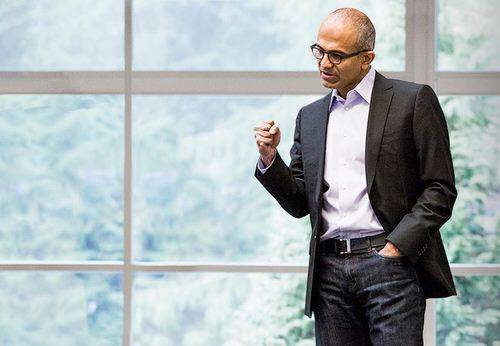
Microsoft CEO Satya Nadella is serious about change. So serious that today he spent $200 million in Microsoft cash for Acompli, a provider of a cool mobile email program … that doesn’t work with Windows Phone.
Not yet, anyway.
The Acompli acquisition is one more sign that Microsoft finally groks, after a decade of misspent middle age, this brave new world of mobile, cloud and open source.
Goading The Giant
With more than $80 billion in cash sitting around its Redmond headquarters, Microsoft can afford to dabble in whimsical interests. But Acompli feels like anything but.
It’s not that Microsoft needed to take out a serious competitor. Acompli is a mere 18 months old with an infinitesimal fraction of Microsoft’s Exchange/Outlook user base. Yes, people at hundreds of different companies across the globe use Acompli, including many at Fortune 500 companies, but Microsoft didn’t buy Acompli for its customer base.
Instead, Microsoft bought its way into the 21st Century of mobile.
The irony is that Acompli CEO Javier Soltero made this point back in April, happily sticking his finger in the eye of Microsoft’s mobile incompetence:
What should users expect if and when Outlook for iOS comes out? Based on Office for iPad, we can’t expect much more than we’ve already seen. Expect a product that’s married to Office365, with limited-to-no support for alternative email accounts, and a lack of imagination about what email on mobile should look like.
But it wasn’t just an inability to get its finger on the mobile zeitgeist, he continues. It’s also a problem matching user expectations with mobile realities:
Microsoft has a fundamental problem with Outlook on the iPad; namely, decades of built up user expectation. You see, the moment ‘it looks and smells like Outlook,’ the user immediately expects parity with the desktop experience, the dominant use case with which they are most familiar. No iPad or mobile app can live up to that expectation. The reality that someone may want to use a single app on their mobile device for various accounts, including non-Microsoft ones, forces trade offs and technical challenges Microsoft is going to have a hard time addressing.
To its credit, Microsoft apparently also recognized this, perhaps with Soltero’s snarky help. Unlike Microsoft of the Steve Ballmer era, however, it has actually decided to do something about it.
A Kinder, More Open Microsoft
Let’s be clear about what this means: Microsoft has been humbled. You can see this in its Acompli acquisition, but also in how the company has embraced open source and cloud. Specifically, it’s how Microsoft has blended those two trends that has proved such a potent humility tonic for Microsoft.
See also: The New “One Microsoft” Is—Finally—Poised For The Future
The old Microsoft built Azure, its cloud platform for developers and companies, by focusing on Microsoft services. As it turned out, developers weren’t very interested. They wanted open source.
After some fits and starts, Microsoft started to get open source religion. It was something of a tentative start, with open source largely shunted off into its Microsoft Open Technologies subsidiary lest the company be tainted. As Open Source Initiative board member Simon Phipps said at the time, “The new Microsoft Open Technologies, Inc. provides an ideal firewall to protect Microsoft from the risks it has been alleging exist in open source and open standards.”
But over time the nature of Microsoft Open Technologies and open source at Microsoft has changed.
As Gianugo Rabellino, senior director of Open Source Communities at Microsoft, told me over email:
Open source is absolutely pervasive in Microsoft, and a lot of initiatives happen outside of MS Open Tech and are managed by the Engineering Groups (EGs in Microsoft parlance): two prime examples are the contributions to the Linux kernel and the Hadoop work. Again, two places where we are plugged in and supporting from a “programs office”/consulting point of view, but directions and actual management are fully in the hands of the EGs. If you want to find more examples for that, look no further than https://microsoft.github.io where MS Open Tech is well represented but still far from being the major contributor.
Today’s MS Open Tech acts as an advisory board of sorts within Microsoft, not the firewall it used to be. That’s progress.
‘Open Sourcing’ Azure
Even more illustrative of that progress, however, is Microsoft’s embrace of open-source software on Azure, because it demonstrates Microsoft’s commitment to developers is more than a silly song and dance. Back when Microsoft dominated it could dictate. Now it needs to meet developers on their own terms.
See also: Meet Microsoft’s Unexpectedly Smart Windows 10 Charm Offensive
So, while Microsoft still releases its own NoSQL database service, it has also embraced MongoDB, Redis, Cassandra and more. Similarly, Microsoft has its own content management technologies like SharePoint, but it also happily runs Drupal, Joomla, Moodle and more.
In fact, the list of open-source technologies supported on Azure is kind of amazing, especially considering that just over 10 years ago open source was considered a cancer in Redmond.
This is a different Microsoft, a more humble, more open Microsoft. While some of this started under Ballmer, it has found a wholehearted welcome with Nadella. It’s a new era for Microsoft, one that makes it look like a contender again.
Lead photo courtesy of Microsoft









